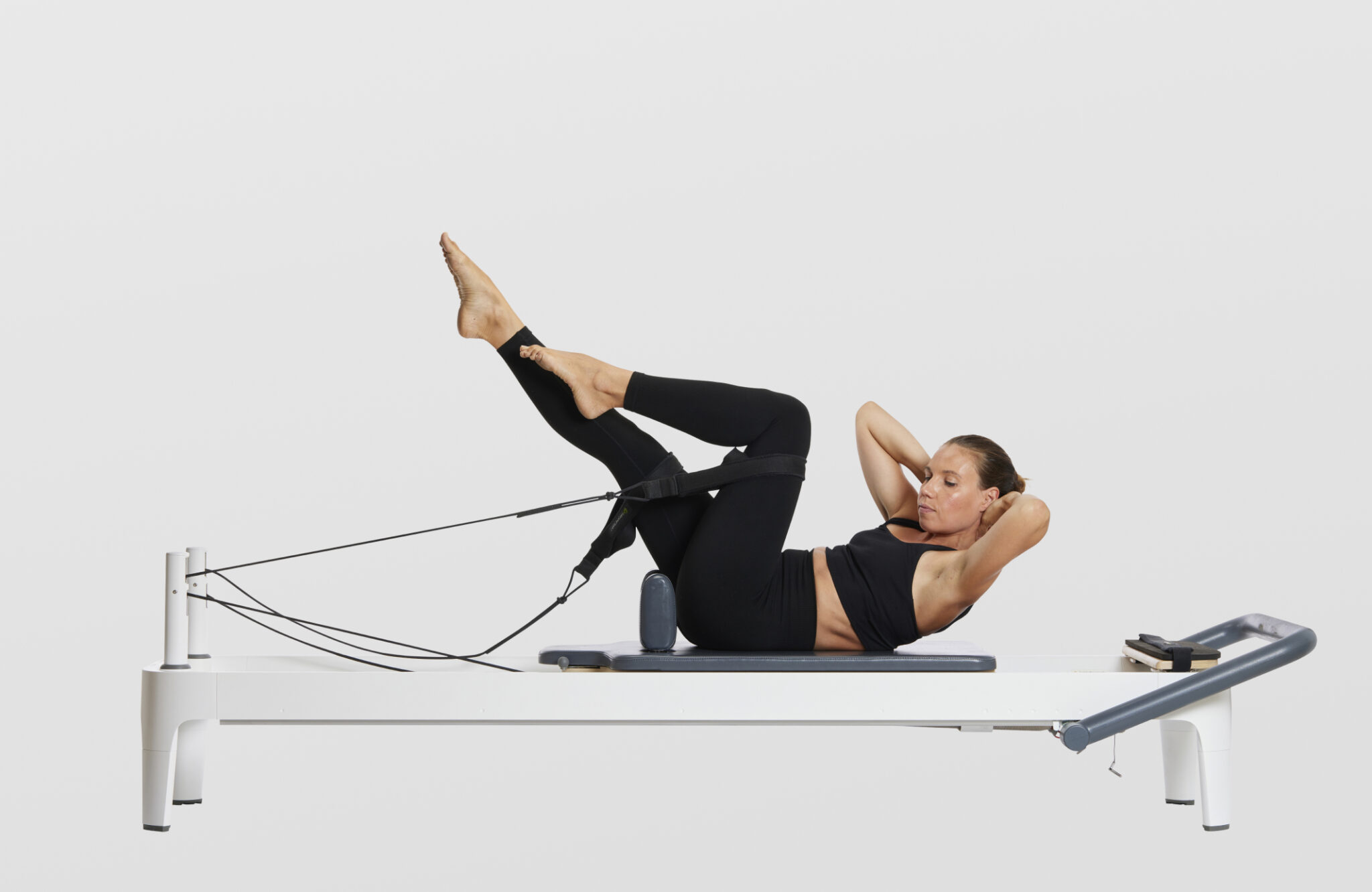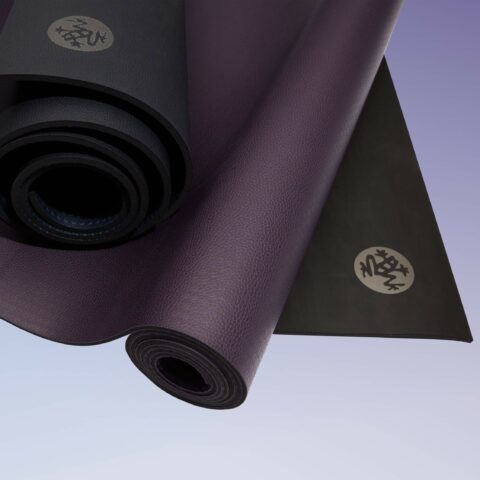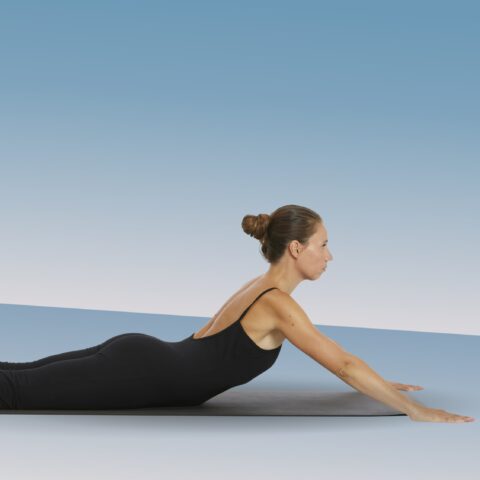If you’re thinking of diving into Pilates, one of the first questions you’ll face is: “What is the difference between Mat Pilates vs Reformer Pilates?” In this article, our experts explore the benefits and challenges of Mat and Reformer, providing an easy-to-understand comparison of the two to find which one is best for you.
Understanding the difference between mat Pilates vs reformer Pilates

What is mat Pilates?
Mat work emphasizes precise movements, proper form, and breathing techniques to connect mind and body as a holistic practice.
Exercises are low-impact, relying on your own body weight for resistance. They primarily focus on building strength in the muscles that support the core and spine. Additionally, they aim to improve flexibility, balance, and body awareness.
Many exercises are done in a sitting, lying, or all fours position, while contemporary classes often include standing positions as well. Because little equipment is needed and movements are easily modified, the practice is accessible to all fitness levels, and just as easily done at a studio as from the comfort of your home.
The flexibility of this practice makes it a convenient and common choice for beginners.
The benefits of a mat Pilates
Quality core
Matwork Pilates exercises are designed to engage specific muscle groups, particularly deep abdominal and back muscles.
This targeted approach relies on your own strength and stability, while contributing to better alignment and improving posture. Think of movements like the Pilates Hundred, Roll-Up, and Scissor that require stability in the spine and engagement through the core center.
So, if you’re up for more exercises that’ll make your core say ‘thank you’, Mat Pilates is your go-to!
Tailor your practice
Another benefit is adaptability. Many mat exercises can be modified to suit those joining a class for the first time or advanced practitioners looking to challenge their practice.
This adaptability extends to those with various physical conditions and injuries. Because exercises can be adjusted, it’s an excellent option for rehabilitation as well as prevention. It offers a safe and effective way to strengthen and stretch in ways that feel best in your body.
No equipment needed
Part of the beauty in a mat workout is the simplistic approach. Only a soft surface and space to move is really needed, which means expensive equipment isn’t necessary to start. Without the need for equipment, you can practice anywhere, anytime, making it the perfect workout to fit into your busy schedule.
Cost friendly
Because a mat pilates class doesn’t involve a lot of equipment, classes are typically cheaper than other Pilates types, making it an easy and affordable choice for many. Wether you’re practicing in group classes at a studio or doing mat work from the privacy of your home, mat classes are going to be the more cost friendly option.
You can start your mat practice for free with our seven day free trial to BAY STUDIOS+ today.
The benefits of mat Pilates at a glance
- Enhances core strength and stability
- Increases flexibility
- Develops balance and coordination
- Boosts endurance and energy levels
- Injury prevention and recovery
- Enhances mind-body connection
- Cost-effective and convenient
- Easily modified
- Improves posture
- Little to no equipment needed

What is reformer Pilates?
If you haven’t tried a Reformer Pilates class, you might be wondering, “What exactly is a Reformer? And what is the difference between Mat Pilates vs Reformer Pilates?”
The Reformer is a machine that challenges and supports the body during Pilates exercises. The founder of the Pilates Method, Joseph Pilates, created the Reformer with the intention of diversifying the method to make workouts more balanced and comprehensive.
It’s essentially a bed-like frame with a moving platform on it, called the carriage. The Reformer adds resistance to movements through various detachable springs attached to one end of the sliding carriage, allowing you to customize the difficulty level of each exercise.
Thanks to the adjustable springs, straps, and foot bar attached to the Reformer, certain movements are assisted, developing strength and form to later perform these movements in a mat class where you would use only your own body weight.
At the same time, the customizable features make other movements more challenging, introducing greater weighted or balancing elements. Cardio elements can also be found in those Pilates Reformer classes that include a jump board, a flat board that allows you to jump on the machine.
Reformer exercises can be done standing, sitting, lying, and in many other positions in, on, or around the machine. Because a Pilates Reformer machine is essential to the practice, it’s often done in a studio setting, making it the more expensive and time consuming option over its Mat Pilates counterpart. Still, those who crave variety and group dynamic might just find the price tag worth it.
In a nutshell, Reformer Pilates is a dynamic and versatile workout. It introduces new levels of resistance and variety to traditional Pilates exercises, offering a significantly different experience than other Pilates class types.
Benefits of reformer Pilates
The whole-body workout
Reformer Pilates engages muscle groups simultaneously to create a full-body workout. The customizable resistance created from the spring system allows you to add more weight or resistance to movements, challenging strength at every level. The resistance also helps develop mobility across the entire body.
Versatile movements
The range of exercises available on a Reformer machine far exceed what’s possible with a mat alone. The machine allows for more variety in positions, expanding on classical Pilates movements for a comprehensive workout. This diversity can make workouts more engaging for those who crave variety.
Improve balance and flexibility
Because a lot of Pilates Reformer work calls for balancing on an elevated surface, movements require continuous engagement of the core muscles for stabilization, fostering a better sense of coordination and balance over time.
Additionally, Reformer movements allow for a greater range of motion that can be adjusted with the help of the machine, helping you to gradually improve your flexibility as your practice grows.
Personalized instruction
While some might enjoy the flexibility to practice on their mats in a moments notice, those who enjoy Reformer Pilates might be looking for more personalized instruction, as this method is typically practiced in person.
In a studio setting you can benefit from individualized feedback on your movements to enhance performance and reduce the risk of injury. Moreover, group settings can create a sense of community and support systems, making your workout experience more interactive.
Benefits of reformer Pilates at a glance
- Improved strength and muscle tone
- Greater range of motion
- Better balance and coordination
- Develops spatial awareness (proprioception)
- Increases endurance and stamina
- Machines are customizable to assist or challenge
- Certain exercises have a high calorie burning potential
- Enhances mind-body connection
- Improves posture
- Injury prevention and recovery
The difference between mat Pilates and reformer Pilates
Both Mat Pilates and Reformer Pilates reap similar benefits, but the main difference between Mat and Reformer is the Pilates equipment required. This will affect the cost and time commitment of your Pilates practice, along with how “load” is applied to your muscles in any given exercise or position.
Mat work generally offers a more accessible route for beginners with its simplicity and minimal practise equipment. This minimal approach means classes are less of a financial investment, and because there is greater flexibility in regards to practicing at home or at a Pilates studio, there may be less of a time investment as well.
But don’t let the minimal approach fool you. From beginner to advanced mat classes you’re going to find a challenge in your practice that can lead to toned muscles along with all of the other benefits we outlined earlier.
Meanwhile, a Reformer Pilates practice means that you’re going to need costly equipment, which means a more substantial financial investment in your practice whether you opt to purchase a Reformer for your home or carve out time for studio classes. However, for many, classes are worth the price tag.
The machine’s adjustable features allow you to progress at your own pace. Beginners can adjust the springs to provide more support, while those looking for a challenge can ramp up the intensity of each exercise. However, it isn’t necessarily better than Mat Pilates – it just offers a different approach to working out and improving bodily strength and flexibility.
8 key differences between reformer Pilates and mat Pilates
- Mat uses body weight, and Reformer uses springs for resistance
- Mat requires minimal equipment, and Reformer requires a machine
- Mat can be done at home, Reformer typically requires a studio
- Reformer offers a more strength-based workout
- Mat is accessible for beginners considering the cost and equipment
- Reformer is accessible for beginners considering modifications
- Reformer is the more expensive option
- Reformer has a greater exercise variety
Is mat Pilates or reformer Pilates better?
While both Mat and Reformer focus on core strength and have similar benefits, their differences will determine what’s most important to you. If you prefer a more focused, traditional, lower-cost approach, Mat Pilates might be your game. If you’re after a balanced exercise you can modify to increase intensity as you progress, Reformer Pilates could be your pick.
Of course, the best pilates practice for you will be the one you actually enjoy doing. If you’d like to get started with Reformer Pilates classes, you can find them at our Pilates studio in Helsinki.







